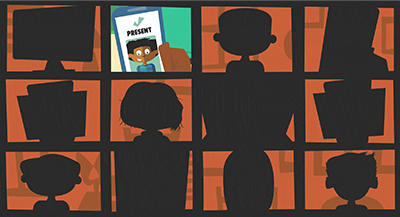
Like so many ideas today, this one sparked after seeing an exchange on a local school district’s social media page.
A notification of grab-and-go meals for virtual learners was met with a comment, “Again, nothing near where I live.” At first, this type of response is frustrating—particularly for burnt-out educators simply trying their best to get meals to learners. But after a moment of reflection within the context of the community, a deeper realization struck: the families in this particular community have been conditioned not to need or ask for help. What this response actually meant was “I need help getting this meal.”
Inspiration soon followed. Imagine the impact of using auto-generated, multiple-choice response in communications that accommodate that request for assistance. It could take the internalized shame right out of the equation, having help be a standard option or choice. I need help getting this meal. Knowing the audience and tailoring responses accordingly could make communication more productive and less divisive.
The era of increased communication
There really isn’t a way to overcommunicate these days. Opportunities for feedback are overwhelming, and the impact on schools has been transformative. Surveys, listening sessions, focus groups, and other forms of gathering direct feedback from the community have helped guide an otherwise unmanageable set of challenges, pivots, and new solutions to a plethora of exceptional circumstances. Communication has improved quickly, and students are seeing the benefits in schools more tailored to their needs than ever before.There is no better time to improve than when you’re already improving.
Productive communication
It’s not enough to simply gather opinions. Leaders must have a way to analyze the information they receive and use the insight to guide decision-making. So how can improved stock responses make that process easier?Returning to the original example for inspiration, the key is applying a radical level of empathy.
Radical empathy, or radical compassion as philosopher Khen Lampert wrote in 2003, directs a special level of empathy toward the distress of others. In particular, it drives those who practice it to change reality to alleviate the pain of others. It’s the next generation of recognizing the challenges faced by community members—now we want to do something about it, take action, make change. And the best way to do that is to leave behind the paternalism of knowing what’s best, and instead ask what our community needs.
The limitation of gathering this type of information exists when administrators work to implement changes at scale after receiving individual feedback. That challenge is very real, particularly to district-level administrators trying to make decisions on behalf of thousands of families, each with a different idea of what would be most comfortable for them. I need help getting this meal cannot always end in the solution so the school has a duty to deliver it directly to me. However, the disconnect of scalable solutions cannot prevent a solution from being decided and implemented.
Enter the productive communication form.
Distill responses into to automatic forms
One of the first methods of scaling communication can eliminate those who are not in dire need of assistance. There will be a sizable chunk of families who can function quite well without support from the school district, and while every student is entitled to resources, families opting out helps districts know where to focus intensive assistance.How can we possibly use automated forms to distill responses from hundreds of families into actionable insight? Rather than starting out with open-ended responses, starting with binary options can help sort responses into groups.
I do not need help getting this meal.
I need help getting this meal.
From there, responses can become more granular, guiding district decision-makers to provide solutions according to what makes the most sense for the both the community and the district. The nice thing about simplifying options is also the ability to keep responses more conversational. Even if it takes more questions overall to get there, the insight you unearth will be more distilled and straightforward.
Applying cultural context to craft better stock responses
Our example is about meals and is location-based, but your mileage may vary. In addition, the insight gathered didn’t necessarily come from the wording of the response; it came from analyzing feedback within the context of the community.It takes creativity, empathy, and most of all, avoiding the temptation to take feedback personally (a tall order in education, where educators have been conditioned to give freely of themselves to the point of burnout). Once leadership teams take their personal opinions out of the equation, it becomes easier to craft responses based on how others would want to be treated, instead of how you think they’d like to be treated.
Look no further than the strong school culture you’ve been nurturing (which may feel a little stagnant while there are bigger fish to fry; it’s okay!). What do students in your district need to be their best selves, and the best representation of your mission and vision? What are they missing that your team can provide? This lens can help guide the way to better communication through carefully crafted stock responses.
Communication certainly takes time, but it’s worth the effort to achieve a more productive conversation and increase engagement with families. In the end, students are the ones who reap the benefits.
Follow-up resources: Connect with families
Learn 11 ways to reach out to families for better engagement.WHAT'S NEXT FOR YOUR EDTECH? The right combo of tools & support retains staff and serves students better. We'd love to help. Visit skyward.com/get-started to learn more.

|
Erin Werra Blogger, Researcher, and Edvocate |
Erin Werra is a content writer and strategist at Skyward’s Advancing K12 blog. Her writing about K12 edtech, data, security, social-emotional learning, and leadership has appeared in THE Journal, District Administration, eSchool News, and more. She enjoys puzzling over details to make K12 edtech info accessible for all. Outside of edtech, she’s waxing poetic about motherhood, personality traits, and self-growth.


.jpg)

